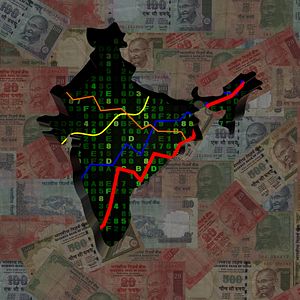India was the world’s top recipient for foreign direct investment in 2015, according to a new report by the Financial Times‘ fDi Intelligence unit. The report (PDF), which charts global data and trends in FDI across the world, notes that “the big FDI story of the past year is India.” Mirroring the Indian economy’s unique place as the world’s top performing large emerging economy over the past year in terms of GDP growth, India has seen its FDI inflows grow over the last year.
Notably, with $63 billion in inbound foreign investment, India has overtaken China as the top global destination for FDI. India has also seen growth in both project numbers and capital investment over the past two years, the report notes, while China saw a 24 percent decline in capital investment and a 16 percent decline in projects in 2015. The FDI story between the two giant Asian emerging economies mirrors the broader growth story. Starting last year, China has seen its overall growth rates begin to falter amid difficulties arising from the government’s attempt to manage its ongoing transition from an investment-driven growth model to a consumer-driven one.
India, meanwhile, has seen its fortunes improve. Kavan Bhandary attributes India’s poor FDI fortunes prior to 2013 not only to China’s status as a more attractive investment destination, but to poor government policies and excessive regulation. “Factors such as the lack of progressive FDI reforms, retrospective taxation, excessive permit requisites, centre-state political stalemates, inflexible labour markets, land acquisition issues and inadequate infrastructure hindered large-scale FDI into India prior to 2013,” he writes.
Bhandary credits Indian Prime Minister Narendra Modi, who was elected in May 2014 on a platform of center-right economic policies, for turning things around for India. “India’s dramatic ascension in the global FDI rankings has largely been due to a dynamic Modi-led government focusing on ‘big bang’ FDI and labor law reforms,” he writes. The Modi government has additionally introduced a ‘Make in India’ initiative, which seeks to turn India into a global manufacturing powerhouse of the sort that helped China torpedo to the top of the emerging economy stack in the 2000s.
A Mixed Regional FDI Picture
The fDi Intelligence report offers a mixed picture of the FDI landscape in the Asia-Pacific region more broadly. India accounted for 20 percent of the Asia-Pacific FDI market share, followed by China at 18 percent and Indonesia at 12 percent. Indonesia’s capital investment inflows increased by 130 percent to $38.5 billion. Vietnam, meanwhile, accounted for 7 percent; Hanoi may be poised to see its market share improve as the Trans-Pacific Partnership moves toward implementation as well. Overall, however, the Asia-Pacific region saw a significant 29 percent decline in total capital investment in 2015.
In addition to India, another bright spot for FDI inflows was Pakistan, which saw its capital investment increase by 147 percent year-on-year. Inbound investment into Pakistan by China and Russia likely helped this figure. Last year, China and Pakistan launched a major $46 billion economic corridor project, which will see Chinese financing for several projects in Pakistan.

































